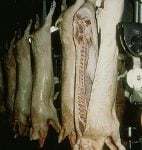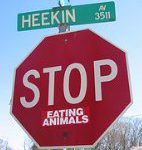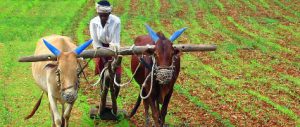“Swine Flu Fears Grow” read a typical recent headline in a New York City tabloid. The article spoke of emergency rooms being “swamped” and schools closed as “panic” spreads. Meanwhile, on the Chinese mainland, there have been at least 441 cases of swine flu, but as yet no deaths. The mayor of New Orleans, Ray Nagin, and his wife were quarantined in a Shanghai hotel last month after a passenger on their flight showed “flu-like” symptoms.
As in New York, many Chinese are unsettled by the arrival of swine flu. “I suddenly had a temperature and was facing the difficulty of whether or not to go to a hospital or quarantine myself,” a Beijing-based colleague wrote recently about his delayed travel. “It revealed to me very vividly how epidemic changes us socially and psychologically.”
Swine flu cases have been documented in 100 countries so far. The outbreak’s origins have yet to be established, although large-scale pig facilities in Vera Cruz, Mexico (run by a subsidiary of US agribusiness giant Smithfield Foods) where the flu was first documented, remain a locus of interest. Such “factory farms” confine thousands of pigs and other domesticated animals in small cages or crates in indoor sheds. The crowding, wastes and stress create conditions in which diseases can spread from animal to animal – and sometimes beyond – often rapidly. China today has more than 60,000 of these factory-style facilities.
Over the past 60 years, vast changes in agricultural production, including use of chemical-based fertilisers and adoption of intensive confinement systems have made meat much more widely available and affordable than it was in the past. Perhaps nowhere else than China has this “livestock revolution” and the shift from diets based on plant foods to those much heavier in animal products been more striking or more visible.
As its rapid economic expansion has allowed more and more Chinese to enter the new middle class, meat has moved from the side of the dinner plate to the centre, particularly in China’s many metropolises. Since 1980, overall meat consumption has quadrupled to its current level, 54 kilograms (119 pounds) per person each year.
That’s still only about half the annual meat consumption per capita of the United States, which hovers around 100 kilograms (220 pounds). But with every fifth person in the world Chinese, even small increases in individual meat and dairy consumption will have broad environmental, climate, health, and food security impacts. What China eats, and how it produces its food, affects not only the country, but also the world.
And while China is not yet a bona fide "factory-farm nation" like the United States and most of Europe, the strains of its fast-growing livestock sector are becoming harder to ignore. Indeed, swine flu comes on the heels in China of recent, deadly outbreaks of avian flu, severe acute respiratory syndrome (SARS) and 2007’s “blue ear” scare that killed tens of thousands of pigs, all of which have rattled food markets around the world.
Even as the shift in China from small-scale to industrial-scale production continues, recent research in several Chinese provinces found that concentrated farming systems were hardest hit by the avian flu, not small-scale or backyard producers, whose free range methods have been accused of incubating animal disease. The United Nations Food and Agriculture Organization (FAO) has cautioned against a wholesale adoption of factory-style systems. “Excessive concentration of animals in large-scale industrial production units should be avoided,” it said in 2007, “and adequate investments should be made in heightened biosecurity and improved disease monitoring to safeguard public health.”
But China’s farmed animal population is in the tens of billions, and it is the world’s largest producer—and consumer—of agricultural products. Factory-style methods of production and processing are becoming increasingly embedded. The government has welcomed investments by major multinational meat and dairy producers and animal feed corporations, including Tyson Foods, Smithfield and Novus International, in producing and slaughtering facilities. (A joint venture between Tyson and China’s Jinghai Poultry Industry Group aims to process one million chickens a week at a facility near Shanghai, when it is operating at full capacity.) Fast food is now a US$28-billion-a-year business in the country. McDonald's, a major sponsor of the Beijing Olympics, has nearly 1,000 restaurants across China.
“When I was a child, every person was allotted one pound of pork a month,” recalls Peter Li, who grew up in Jiangxi province in southeast China and is now a professor of political science at the University of Houston in Texas. “We could not eat more than that. You could not get it. Now, though, more people have access to more meat and want to eat a lot of it.” In becoming an agricultural powerhouse, and a leading protein producer, China is overcoming a bitter historical legacy. The Chinese, Li suggests, are now “eating meat in revenge” for past disastrous government actions.
Over the past 10 years, consumption of pork, China's most popular meat, has doubled, and China has surpassed the US as the world's top pork producer. It raises and slaughters more than 700 million pigs a year. In 2008, the largest ever such tranche ever recorded, 1.925 million tonnes of pork were imported (about 5% of China's overall pork consumption). China’s is also the world’s leading producer of “meat” chickens.
The industrial model of animal agriculture is, by its proponents, valued for efficiencies of scale unavailable to small- and medium-sized farms. But factory farms also carry significant environmental and social costs, costs that have become increasingly evident in recent years in the US and Europe.
A multi-year, multi-disciplinary commission established by the U.S.-based Pew Charitable Trusts and the Johns Hopkins University’s Bloomberg School of Public Health concluded in 2008 that the negative effects of industrial farm animal production are “too great” and the scientific evidence “too strong to ignore.” In a preface to the commission’s final report, its executive director, Robert P Martin, wrote: “The present system of producing food animals in the United States is not sustainable and presents an unacceptable level of risk to public health and damage to the environment, as well as unnecessary harm to the animals raised for food.”
Meat and dairy production use 30% of the earth’s land surface, 70% of agricultural land and account for 8% of the water humans use, mostly to irrigate feed crops. The global livestock industry is, according to the UN FAO, “probably the largest sectoral source of water pollution,” and one of the key agents of deforestation. In the Amazon, for example, 70% of cleared forest is now pasture; feed crops including industrial soy, grown for livestock, including in China, cover much of the rest.
On the crucial issue of climate change, meat and dairy production have a significant role, the FAO’s 2006 study of the sector found. Fully 18% of the world’s greenhouse-gas emissions stem from the livestock industry, surpassing total emissions from the entire global transportation sector. In 2008, China leapfrogged past the US to become the world's leading emitter of carbon dioxide: as the country's farmed animal population expands, emissions will rise, too — specifically those of methane and nitrous oxide, both far more potent greenhouse gases than carbon dioxide.
Animal waste is also a large and growing concern. China's farmed animals produce 2.7 billion tonnes of manure every year, nearly three-and-a-half times the industrial solid waste level. Xu Cheng, a professor at China Agricultural University, estimates that only 3% of China's large and medium-sized livestock operations have facilities to treat animal wastes. Runoff from livestock operations, mainly pig facilities, has created a large “dead zone” in the South China Sea that is virtually devoid of marine life.
For decades, researchers and policymakers asked, "Who will feed China?" Today, the question has changed to, "Who will feed China's pigs?" In northern China, overgrazing and overfarming lead to the loss of nearly a million acres of grassland each year to desert. The resulting dust storms have hit Beijing, Korea, Japan and even crossed the Pacific Ocean to blanket the west coast of North America. Currently, a quarter of China is desert, an area that is expanding by around 5,000 square kilometres a year, north and west. The government estimates that more than 150 million Chinese will need to move, from regions where water resources have been over-exploited and the desert is engulfing homes and farmland.
As demands for meat, milk, as well as China’s dietary staple, rice, grow, and as available land and water resources dwindle, the government is looking abroad to ensure food security. It is not only accessing international food markets, but also turning to Africa, Latin America, and other parts of Asia to access land on which to produce food for both people and livestock. As it does, it is encountering charges of a new agricultural imperialism. In 2007, world grain prices shot up by 42% over 2006 levels, putting millions of already poor people at greater risk of hunger and malnutrition. While this phenomenon has many causes, one is the steady growth in demand for grain for feed for farmed animals.
China’s changing diet is also affecting public health. Data from China's Ministry of Health show that in the 1930s, 97% of calories in the average Chinese diet came from grains and vegetables, compared to only 63% in 2002. China's health profile is being reshaped in the US image, and for the worse. A study last year by Barry Popkin, a North Carolina-based professor of nutrition, found that nearly one-in-four adults in China were overweight. Eighty percent of Chinese now die as a result of non-communicable diseases such as heart disease and cancer, often tied to diets high in animal fats and sugars.
In addition, the World Health Organization warns that many "first-line" antibiotics, such as penicillin, are no longer effective against more than 90% of certain bacteria in Asia due to the drugs' overuse in farmed animals. Just before the Beijing Olympics, China's chief veterinarian in the Ministry of Agriculture, Jia Youling, indicated that some Chinese farmers were still using banned growth-enhancing drugs, food coloring, and other chemicals, while feed additives with high concentrations of metals were polluting water and crops.
The recent economic downturn has not spared China’s meat sector. In March, China's poultry “stock” fell by an estimated one-third. Tens of millions of migrant workers have been laid off, so they are not buying as much chicken, nor are their factory lunchrooms serving the quantities they once did. Many chicken slaughter plants have shut down, and feed sales have been affected.
Effects have also been felt far from China. The Chinese drop in demand for chicken has been noted as a major factor in a worldwide fall in the price of soy, a prime chicken feed. Some Chinese orders for US soy have been cancelled. However, most analysts foresee demand for, and production of, meat, dairy products and eggs in China continuing to intensify over coming decades, in line with recent trends.
China's development is proceeding at a pace and scale without precedent in modern human history. Environmental, economic, public health and animal welfare challenges that took decades to become obvious in the west require only years to become visible in China. Will China be able to replicate the industrial animal production model, the myriad costs of which are now being heavily scrutinised in the industrialised world? Perhaps the more important question is this: when the facts are carefully examined, will it want to?
Mia MacDonald is executive director of Brighter Green, a New York-based public policy action tank working at the intersection of environment, animals, and global development. She is also a senior fellow of the Worldwatch Institute.
Brighter Green recently published a study on the issues raised in this article in both English and Chinese, Skillful Means: the Challenges of China’s Encounter with Factory Farming. The full publication in English in PDF format is available here. For the full report in Chinese (a Word document), click here. A Chinese summary is also available here.
Homepage Image by Farm Sanctuary


